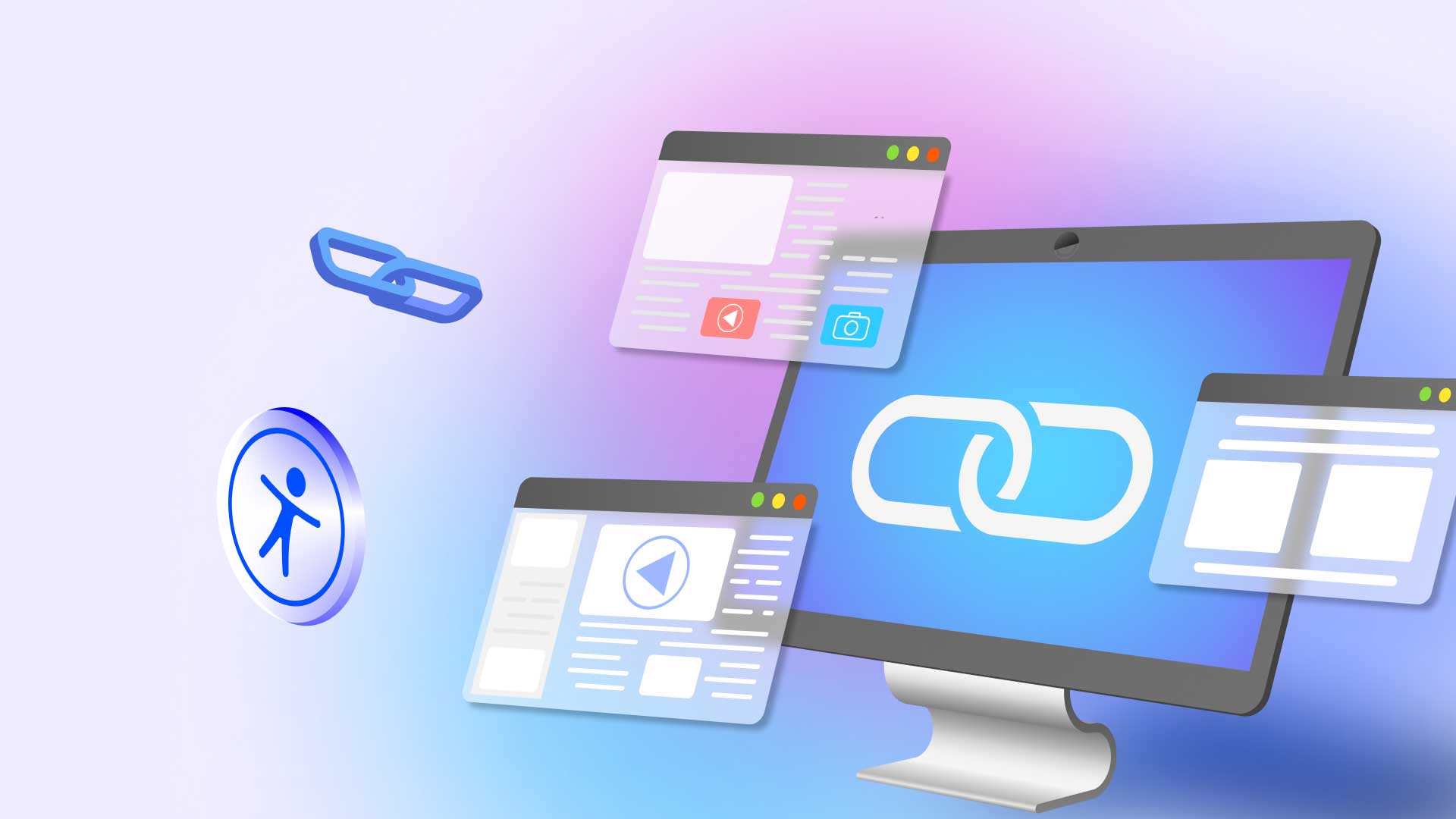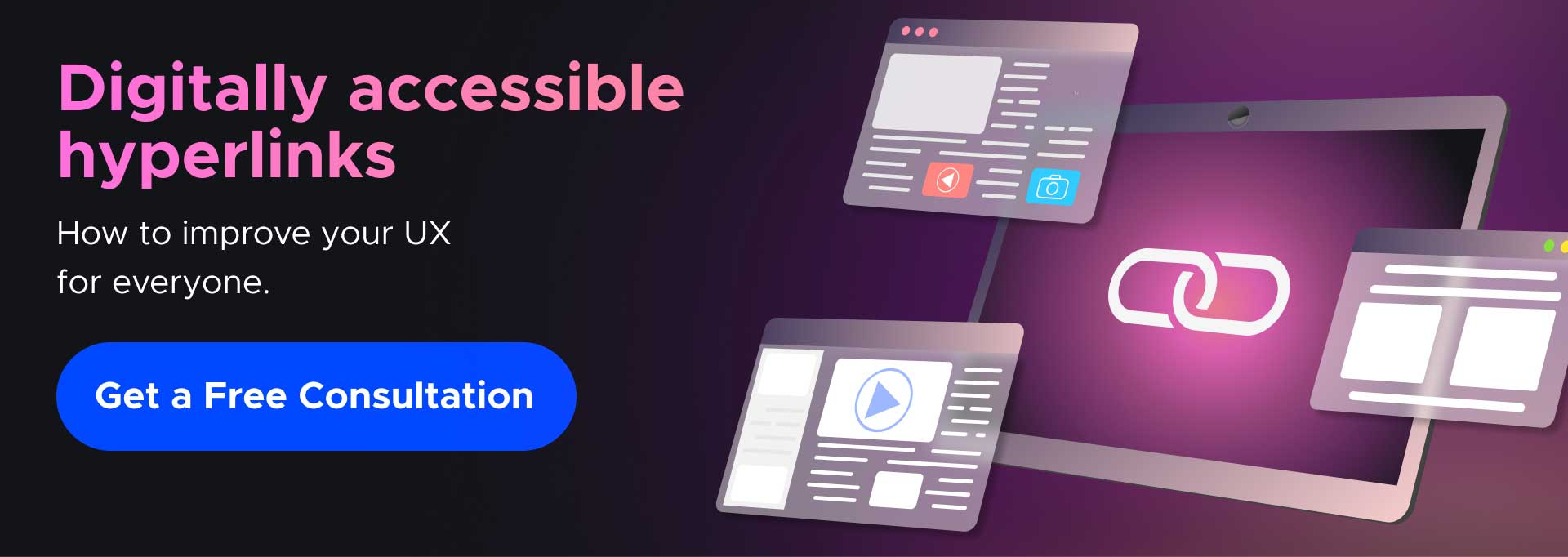The Missing Accessible Links: Hidden Hurdles of Web Accessibility

The digital world has become the go-to destination for many of our needs, whether it’s quenching our thirst for knowledge, indulging in entertainment, handling financial matters, or staying connected with friends. However, there’s a significant issue affecting millions of users, acting as a barrier to navigating the online world with ease – inaccessible links. But what makes a link inaccessible and how can we create accessible links to enable everyone to have better online experiences?
Inaccessible links are like hidden hurdles scattered across the web, creating obstacles to the seamless flow of information for individuals of all abilities. These links can make websites and other digital assets challenging, if not impossible, to navigate for people with disabilities.
In this article, we’ll take a look at the challenges of inaccessible links, shedding light on the importance of inclusive web design, from the use of HTML, images and SEO, and the steps we can take to make the web a more accessible space for all users.
Why are accessible links a crucial part of web accessibility?
Accessible links are the unsung heroes of the online world, ensuring that everyone, regardless of their abilities, can benefit from the digital world. Let’s explore the reasons why accessible links are pivotal to web accessibility:
1. Universal Access
When links are properly labeled and designed, it broadens access to the digital world for a diverse range of users.
2. Navigational Aid
For screen reader users, accessible links provide clear information about where a link leads. Properly labeled links enable users to understand the context and purpose of the link, making it easier to decide whether to click on it or continue exploring the content.
3. Contextual Understanding
Accessible links provide context and convey the relationship between linked content and the surrounding information. This is particularly important for users who rely on screen readers or other assistive technologies. When links are descriptive and convey their purpose, it aids users in understanding the relevance of the linked content.
4. Legal Compliance
Web accessibility is also a legal requirement in many regions. Governments and organizations worldwide have implemented regulations such as the Web Content Accessibility Guidelines (WCAG) to ensure that digital content, including links, is accessible to all. Non-compliance can result in legal consequences and damage to an organization’s reputation.
So, how do you practically put accessible links to work in your web design? Let’s explore a few practical strategies to create links that are accessible to all.
HTML: A practical strategy for accessible links
HTML forms the foundation of creating accessible links, so let’s begin by clarifying what a hyperlink is.
A hyperlink, or simply a “link,” serves as a clickable element on a webpage. When activated, it redirects users to another location, such as a web page, a specific section of a webpage, a file, or even an email address. These links enable seamless navigation between different web pages on the internet. They are often visually highlighted or underlined, appearing as text, images, or buttons.
How to create a hyperlink in HTML
Have you ever wondered how to create a hyperlink? How can you make a link clickable? Making a hyperlink that is clickable is as simple as using the `<a>` tag. But there’s more to it than meets the eye…
How to link to a website in HTML
When you want to direct your website visitors to an external web page, you can create a hyperlink. This is commonly done using the `<a>` tag in HTML. For instance, to link to the website “https://www.userway.com” and display the text “Visit UserWay,” you would write:
<a href=”https://www.userway.com”>Visit UserWay</a>
But what if you want to make an image clickable, so when users click on the image, it takes them to a website? That’s where image hyperlinks come into play.
How to create image hyperlinks
Image hyperlinks allow you to transform images into clickable links. It’s like turning a picture into a portal. To create an image hyperlink, you can use the same `<a>` tag, but this time, you wrap it around an `<img>` tag, which displays the image. Here’s an example:
<a href=”https://www.userway.com”>
<img src=”image.jpg” alt=”Click me for more information”>
</a>
In this example, when users click on the image, they’ll be taken to “https://www.userway.com.” The `alt` attribute in the `<img>` tag provides a description of the image for accessibility purposes.
So, whether you’re linking to a website with text or turning an image into a clickable link, these methods help you create accessible hyperlinks that enhance the user experience on your website.
ARIA labels and accessible links
When it comes to link functionality, building accessibility into a website isn’t only found in the visible text – it’s in the code beneath the text too. Enter ARIA labels, the hidden champions of web accessibility.
ARIA, or Accessible Rich Internet Application, labels are HTML attributes with a mission: to provide a clear and accessible name or label for web elements that might lack inherent identification or need a more descriptive one. While some users might rely on surrounding content to grasp a link’s destination, people using assistive technologies rely on ARIA labels for that extra layer of insight.
But here’s the twist: just inserting on an ARIA label doesn’t automatically make a link accessible. Here’s how to get it right: Embed your ARIA label as an attribute within the HTML tag. And remember, moderation is key. Keep your ARIA labels concise and always prioritize meaningful link text.
Similar to ARIA labels, there’s another often underestimated facet to web accessibility that we cannot afford to ignore. Let’s now look into SEO and its connection to accessible links.
SEO: The Unexpected ‘Accessibility Ally’
Search engine optimization (SEO) and accessibility are often viewed as separate disciplines, however they are more interconnected than you might think. In fact, when creating accessible links, SEO can be a huge ally. Here’s how accessible links can benefit your website’s SEO efforts.
1. Enhanced User Experience
Accessible links aren’t just accessible to users with disabilities; they create a smoother, more enjoyable experience for all visitors. Search engines reward websites that prioritize user experience, ranking them higher in search results.
2. Content Discoverability
Search engine crawlers rely on links to navigate and index content. When your links are clear, descriptive, and accessible, search engines can better understand your website’s structure and the relevance of your content.
3. Reduced Bounce Rates
Accessible links help users find the information they seek, reducing bounce rates (when visitors quickly leave your site). Lower bounce rates indicate to search engines that your content is valuable and relevant.
4. Mobile-Friendly Ranking
With the increasing importance of mobile search, accessible links contribute to mobile-friendliness. Google, for example, prioritizes mobile-friendly websites in its rankings.
5. Inbound and Outbound Links
Inbound and outbound links are important ranking factors. When your website has accessible links, it can encourage other websites to link to your content. For example, the quality of link anchor text, ( the clickable text in a hyperlink), plays a significant role in web accessibility and SEO optimization.
Ready to learn more about creating accessible links and how they can positively impact your website’s SEO efforts? Read our article titled “SEO and Accessibility Go Hand in Hand.
UserWay: forging inclusive pathways with accessible links
With every website we build and every link we craft, we can open doors or build walls. UserWay helps organizations build accessible design principles and commit to web accessibility best practice. The next time you place a link, remember its power. It’s more than just a hyperlink—it’s a vital way to ensure your digital assets are welcoming to all users .Chat with our team today and let us assist you in your web accessibility journey.
Common FAQS
What are accessible links?
Accessible links are hyperlinks on web pages designed to be easily perceivable and operable by individuals with disabilities, ensuring equal access to online content.
How can I make links accessible?
To make links accessible, use descriptive and meaningful link text, ensure proper formatting and contrast, and consider the needs of screen reader users and keyboard navigation.
Why are accessible links important?
Accessible links are vital for inclusivity, legal compliance, and improving user experience, allowing a diverse audience, including individuals with disabilities, to access and navigate web content effectively.



Share